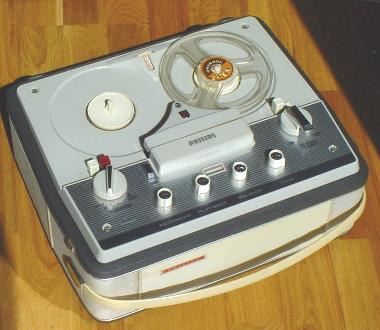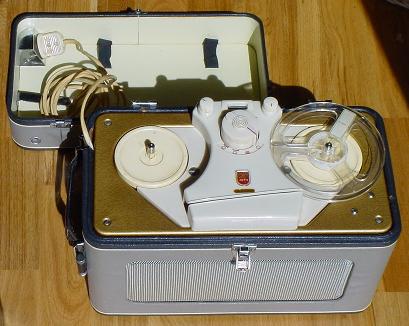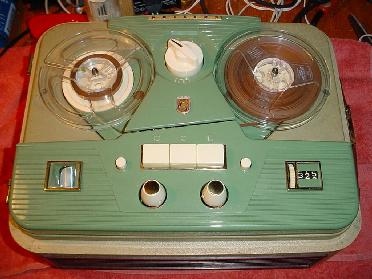|
This is a rather large jump forward in time, to the start of the 1960's,
1962 to be more exact, when this machine was launched, although it
was in production for several years. The machine depicted is an
early version with metal pause button; later versions had a plastic
button which tended to crack with age, leaving a rather unsightly metal
stud (which would still be operated though).
The EL3547 shown must have been a breakthrough in its day. Fully
transistorized in an era where tubes where still the norm, it also
sported stereo record and playback, with two speakers built in, and
four track operation. Further
features included 'multiplay', later more often called 'sound-on-sound', i.e.
the ability to 'bounce' material between tracks, adding new material at each
bounce. Sadly, the maximum reel size is only 6".
Technically there are a couple of interesting solutions. Upon first opening the
machine up it becomes evident after a while that there is no power transformer!
Closer inspection reveals that extra windings on the drive motor provides
power for the amplifiers.
The machine sports belt drive of the flywheel, but still has two speeds
(3 3/4 ips and 1 7/8 ips).
The belt is moved between two pulley grooves on the motor using a clever
mechanism which lifts the belt from one groove and places it on the other,
operated by the two push buttons to the right.
An interesting style note is how important it was to give an impression of
symmetry. The function control knob on the right is balanced by the
track selector on the left, the four knobs for recording level, playback volume,
balance and tone are symmetrically placed, and the push buttons for record and
multiplay balance the two buttons selecting the two speeds. Only the pause button
causes a distraction from the symmetry, but it is rather small.
The User Manual is available
in PDF format.
Or have a look at the EL3547 and other tape recorders in this
1963-64 Philips Tape Recorder Catalog
(large file; 20 MB, in Swedish).
|

Philips model EL3547
|


